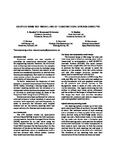Coupled RANS-VOF Modelling of Floating Tidal Stream Concepts
| dc.contributor.author | Ransley, E | |
| dc.contributor.author | Brown, Scott Andrew | |
| dc.contributor.author | Greaves, Deborah | |
| dc.contributor.author | Hindley, S | |
| dc.contributor.author | Weston, P | |
| dc.contributor.author | Guerrini, E | |
| dc.contributor.author | Starzmann, R | |
| dc.date.accessioned | 2019-04-04T09:36:01Z | |
| dc.date.available | 2019-04-04T09:36:01Z | |
| dc.date.issued | 2016-04-25 | |
| dc.identifier.uri | http://hdl.handle.net/10026.1/13616 | |
| dc.description.abstract |
INTRODUCTION Numerical models are now capable of providing the quantitative description required for engineering analysis. However, for structures such as floating tidal stream devices, the complex nature of the system can rarely be included using existing functionality. Typically key aspects of the system are considered separately or omitted from the analysis completely. This leads to a number of uncertainties in both the power delivery and the survivability of these devices. To better understand the behaviour of such systems, a coupled Computational Fluid Dynamics (CFD) model, including a floating barge, hybridcatenary mooring system and the influence of a submerged turbine has been developed and tested at full-scale in conditions based on those at the Perpetuus Tidal Energy Centre (PTEC) site. Simulations have been performed for a device with and without a turbine installed; in waves and currents, both separately and simultaneously; in order to ascertain the influence each coupled element has on the motion, mooring loads and power delivery of a floating tidal stream concept | |
| dc.language.iso | en | |
| dc.title | Coupled RANS-VOF Modelling of Floating Tidal Stream Concepts | |
| dc.type | conference | |
| plymouth.date-start | 2016-04-25 | |
| plymouth.date-finish | 2016-04-27 | |
| plymouth.conference-name | in Proceedings of the 4th Marine Energy Technology Symposium (METS) | |
| plymouth.organisational-group | /Plymouth | |
| plymouth.organisational-group | /Plymouth/Faculty of Science and Engineering | |
| plymouth.organisational-group | /Plymouth/Faculty of Science and Engineering/School of Engineering, Computing and Mathematics | |
| plymouth.organisational-group | /Plymouth/PRIMaRE Publications | |
| plymouth.organisational-group | /Plymouth/REF 2021 Researchers by UoA | |
| plymouth.organisational-group | /Plymouth/REF 2021 Researchers by UoA/UoA12 Engineering | |
| plymouth.organisational-group | /Plymouth/Research Groups | |
| plymouth.organisational-group | /Plymouth/Research Groups/Marine Institute | |
| plymouth.organisational-group | /Plymouth/Users by role | |
| plymouth.organisational-group | /Plymouth/Users by role/Academics | |
| plymouth.organisational-group | /Plymouth/Users by role/Researchers in ResearchFish submission | |
| dc.publisher.place | Washington, D.C., USA | |
| dcterms.dateAccepted | 2016-02-01 | |
| dc.rights.embargoperiod | Not known | |
| rioxxterms.licenseref.uri | http://www.rioxx.net/licenses/all-rights-reserved | |
| rioxxterms.licenseref.startdate | 2016-04-25 | |
| rioxxterms.type | Conference Paper/Proceeding/Abstract |


